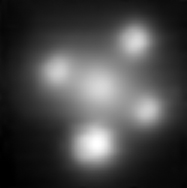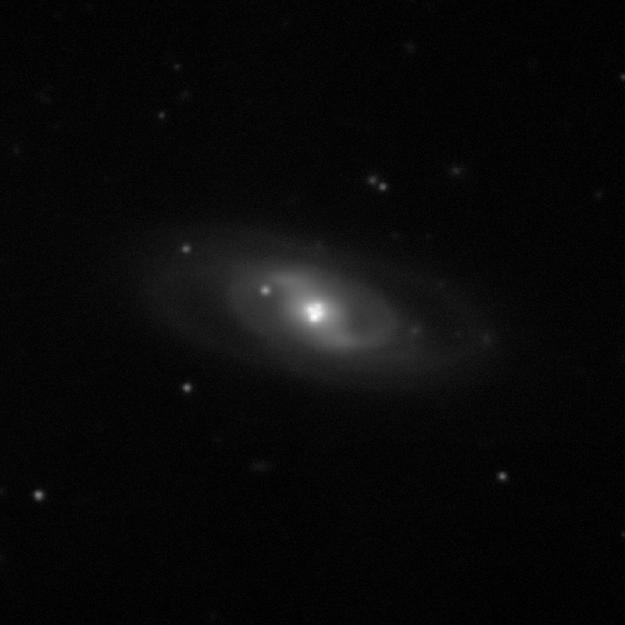This magnification effect, known as "macrolensing", in which a galaxy plays the role of a cosmic magnifying glass or a natural telescope, proves very useful in astronomy as it allows us to observe distant objects that would otherwise be too faint to explore using currently available telescopes. "The combination of this natural magnification with the use of a big telescope provides us with the sharpest details ever obtained," explains Frédéric Courbin, leader of the programme studying the Einstein Cross with ESO's Very Large Telescope.

Close-up of the Einstein Cross, as observed with the SINFONI instrument on ESO's Very Large Telescope. SINFONI makes use of the adaptive optics technique and so, allows astronomers to overcome the blurring effect of the atmosphere, thereby providing very sharp images. The central blob is the nucleus of the lensing galaxy, surrounded by the four mirage images of the distant quasar.
Credit: ESO/F. Courbin et al.
In addition to macrolensing by the galaxy, stars in the lensing galaxy act as secondary lenses to produce an additional magnification. This secondary magnification is based on the same principle as macrolensing, but on a smaller scale, and since stars are much smaller than galaxies, is known as "microlensing". As the stars are moving in the lensing galaxy, the microlensing magnification also changes with time. From Earth, the brightness of the quasar images (four in the case of the Einstein Cross) flickers around a mean value, due to microlensing. The size of the area magnified by the moving stars is a few light-days, i.e., comparable in size to the quasar accretion disc.
Macro and microlensing
The microlensing affects various emission regions of the disc in different ways, with smaller regions being more magnified. Because differently sized regions have different colours (or temperatures), the net effect of the microlensing is to produce colour variations in the quasar images, in addition to the brightness variations. By observing these variations in detail for several years, astronomers can measure how matter and energy are distributed about the supermassive black hole that lurks inside the quasar. Astronomers observed the Einstein Cross three times a month over a period of three years using ESO's Very Large Telescope (VLT), monitoring all the brightness and colour changes of the four images.
"Thanks to this unique dataset, we could show that the most energetic radiation is emitted in the central light-day away from the supermassive black hole and, more importantly, that the energy decreases with distance to the black hole almost exactly in the way predicted by theory," says Alexander Eigenbrod, who completed the analysis of the data.

The Einstein Cross and the galaxy that causes this 'cosmic mirage', as seen with the FORS instrument on ESO's Very Large Telescope. This cross-shaped configuration consists of four images of a single very distant source. The multiple images are a result of gravitational lensing by a foreground galaxy, an effect that was predicted by Albert Einstein as a consequence of his theory of general relativity. The light source in the Einstein Cross is a quasar approximately ten billion light-years away, whereas the foreground lensing galaxy is ten times closer. The light from the quasar is bent in its path and magnified by the gravitational field of the lensing galaxy. Credit: ESO/F. Courbin et al.
The use of the macro- and microlensing, coupled with the giant eye of the VLT, enabled astronomers to probe regions on scales as small as a millionth of an arcsecond. This corresponds to the size of a one euro coin seen at a distance of five million kilometres, i.e., about 13 times the distance to the Moon! "This is 1000 times better than can be achieved using normal techniques with any existing telescope," adds Courbin.
Measuring the way the temperature is distributed around the central black hole is a unique achievement. Various theories exist for the formation and fuelling of quasars, each of which predicts a different profile. So far, no direct and model-independent observation has allowed scientists to validate or invalidate any of these existing theories, particularly for the central regions of the quasar. "This is the first accurate and direct measurement of the size of a quasar accretion disc with wavelength (colour), independent of any model," concludes team member Georges Meylan.





Comments